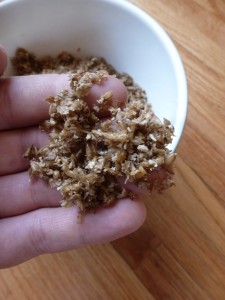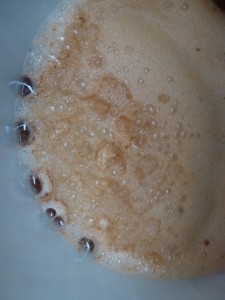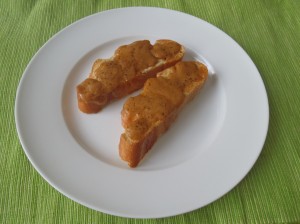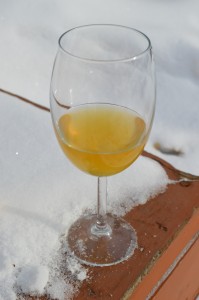 I’ve been doing some all-grain brewing this spring. After the mashing process the malt has given up all its caramel earthiness to the wort, and you are left with several pounds of spent grain, or draff.
I’ve been doing some all-grain brewing this spring. After the mashing process the malt has given up all its caramel earthiness to the wort, and you are left with several pounds of spent grain, or draff.
There are lots of ways to use this stuff up. Commercial breweries commonly sell or give draff to farmers as livestock feed. It can also be composted so long as you have lots of other, greener compostable material to balance out the mixture.
Draff is also commonly baked into bread. Realistically the home brewer will not be able to bake enough bread to use all of the spent grain – the bulk of mine still ends up in the compost heap – but it’s … Continue reading.
During Advent I started writing about brewing beer at home, but I got distracted and didn’t finish all the posts. So far we’ve discussed mashing and boiling, so now we move on to fermenting.
 This post is about fermenting homebrewed wort to make beer. I wrote it on a Tuesday afternoon. Earlier that day I had gone to Sherbrooke Liquor and found that they had bottles of Muskoka Spring Oddity (750 mL, 8% ABV) on sale for $6.99. I first tried this beer in the summer of 2012, and thought it was pretty good: broadly in the witbier style, malty, cloudy, aromatic, laced with spices. While I would never turn down a glass of Oddity, the truth is I’ve … Continue reading.
This post is about fermenting homebrewed wort to make beer. I wrote it on a Tuesday afternoon. Earlier that day I had gone to Sherbrooke Liquor and found that they had bottles of Muskoka Spring Oddity (750 mL, 8% ABV) on sale for $6.99. I first tried this beer in the summer of 2012, and thought it was pretty good: broadly in the witbier style, malty, cloudy, aromatic, laced with spices. While I would never turn down a glass of Oddity, the truth is I’ve … Continue reading.
Having completed our mash, we are ready to boil. What I call “the boil” actually includes a number of steps:
- bringing the wort to a boil,
- adding hops,
- removing coagulated proteins and other impurities, and
- rapidly chilling the wort to fermentation temperatures.
There are several reasons the wort must be boiled:
- The bitterness, flavour, and aroma of the hops are best extracted at a rolling boil.
- Boiling deactivates malt enzymes, setting the gravity of the wort.
- Boiling sterilizes the wort.
- Boiling coagulates proteins and protein-tannin combinations, helping clarify the wort.
- Boiling drives off water, concentrating sugars and allowing the brewer some control over the gravity of the wort.
- Boiling over an open flame can lightly caramelize the wort, adding
…
Continue reading.
As mentioned in the Intro, the primary job of a brewer is to create a fermentable liquid called wort. This involves converting some of the complex starches found in grain to simple sugars, then extracting those sugars into a solution so that yeast can metabolize them and create alcohol, carbon dioxide, and a number of other aromatic and flavourful compounds.
This post is about making wort. It includes info on water, barley, malt, grinding, mashing, lautering, and sparging.
Water. Water is important. Beer is, after all, mostly water. So are we. Historically the water source at a brewery informed the style of beer that they made. Places with alkaline water found that using acidic, heavily roasted malts … Continue reading.
 I consider apple cider to be a generous gift from nature: with a small amount of work you can secure enough alcohol to last a year. There are thousands of well-established apple trees in Edmonton. At this point in time most of the owners can’t or don’t want to use all the fruit, and by volunteering with OFRE or just knocking on doors you have easy access. Once you have secured apples, if you crush and press them, they will, of their own accord, turn into cider. No need to add sugar, or acid, or yeast, or anything. It’s amazing.
I consider apple cider to be a generous gift from nature: with a small amount of work you can secure enough alcohol to last a year. There are thousands of well-established apple trees in Edmonton. At this point in time most of the owners can’t or don’t want to use all the fruit, and by volunteering with OFRE or just knocking on doors you have easy access. Once you have secured apples, if you crush and press them, they will, of their own accord, turn into cider. No need to add sugar, or acid, or yeast, or anything. It’s amazing.
Beer is quite the opposite. Brewing is so complicated, and relies so heavily on human intervention, it’s difficult to imagine … Continue reading.
Yard of flannel is hot ale, laced with rum and spices, and thickened with egg.
Though there’s a surprising number of beer and cocktail blogs that have tried out old recipes of yard of flannel, there’s very little information on the history of this drink available online.
I’ve found no documented link between these two drinks, but yard of flannel is nearly identical in recipe and preparation to an old Scots cocktail called het pint (literally “hot pint”). The only difference is that the Scots version typically uses whiskey instead of rum.
Het pint was once an important part of Scottish celebrations, especially Hogmanay, the Scots New Year. In the 17th and 18th centuries, public houses made het pint on … Continue reading.
 This dish is most commonly called either “Welsh rarebit” or “Welsh rabbit.” “Rabbit” is the original name, though no one knows the origin of the term. Some say it was originally derogatory, suggesting that if a Welshman went out to hunt rabbit, he would end up eating cheese for dinner. The dish is currently experiencing a revival, and modern authors and cooks prefer to use the corruption “rarebit,” as it avoids the obvious confusion with the hopping mammal.
This dish is most commonly called either “Welsh rarebit” or “Welsh rabbit.” “Rabbit” is the original name, though no one knows the origin of the term. Some say it was originally derogatory, suggesting that if a Welshman went out to hunt rabbit, he would end up eating cheese for dinner. The dish is currently experiencing a revival, and modern authors and cooks prefer to use the corruption “rarebit,” as it avoids the obvious confusion with the hopping mammal.
At its heart, rabbit is hot cheese on toast. The best versions also include beer. I borrowed a technique from Fergus Henderson’s book The Whole Beast. He makes a roux, then whisks his beer into it, creating what is essentially a beer … Continue reading.
What makes beer “local”? Is it simply that it’s brewed in Edmonton? Do the grains and hops have to be from Alberta? Do the water and yeast? Could it be that the origin of the ingredients is only one part of the equation? What about how we brew and bitter our grains?
In modern practice, beer is made of grains that are malted, roasted, mashed, bittered with hops, fermented, and carbonated. Which of these processes are necessary, and which are a matter of cultural preference?
Strictly speaking, malting isn’t required, though something must be done to break down the cell walls of the grains, and to convert some of the starches to sugars. Malting prompts the germ of the … Continue reading.
 While reading the maple syrup section of On Food and Cooking, I came across a shocking bit of information.
While reading the maple syrup section of On Food and Cooking, I came across a shocking bit of information.
Even though North American Indians didn’t have metal pots until the Europeans came, they had an ingenious method for reducing maple sap to make syrup. They would leave the sap in the cold air overnight. In the morning there would be ice on top. That ice would be mostly (but not exclusively) water, so in discarding the ice they were left with a higher concentration of sugar in the sap.
After reading this, I immediately turned to the section of the book on distilled spirits, to see if there was any mention of whether this method works to concentrate alcoholic … Continue reading.
The personal website of Edmonton chef Allan Suddaby
 I’ve been doing some all-grain brewing this spring. After the mashing process the malt has given up all its caramel earthiness to the wort, and you are left with several pounds of spent grain, or draff.
I’ve been doing some all-grain brewing this spring. After the mashing process the malt has given up all its caramel earthiness to the wort, and you are left with several pounds of spent grain, or draff.


